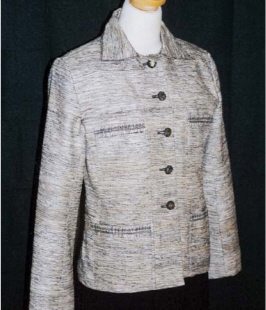
Loosely Woven Fabric
Above Average
Loosely woven fabrics are novelty fabrics with a loose weave. Many are bulky with slubs and long floats. They pick, pull, and ravel badly.
Workroom Secrets
Layout/Cutting/Marking: Many loosely woven fabrics stretch badly; do not allow them to hang off table. For fabrics which fray badly, cut with 1"(2.5cm) seams. Then, before moving the sections from the table, spray lightly with seam sealant or thin solution of white glue and water. Use small safety pins to mark the right side and construction symbols. Avoid clips if the fabric frays badly. Understitch facings to prevent them from popping out.
Stitching: Use a roller foot or wrap toes with tape to avoid snagging long floats. Stitch with a narrow zigzag (W,.5-L,2) to prevent puckered seams. Hold the fabric firmly in front and behind the presser foot; use a roller or even feed foot, or tissue stitch seams.
Seams: Stabilize necklines, shoulder seams, buttonholes, and zipper openings. (See Fabric.)
Seam/Hem Finishes: If the fabric frays badly, serge or bind seams before assembling. Work carefully to avoid changing or varying the seam allowance widths.
Buttonholes: For more definition, use water soluble stabilizer on top of fabric and/or cord the buttonholes. Underlinings: Use sew ins for stability, fusibles for added structure.
Pressing: To avoid flattening the fabric, cover pressing surface with thick towel. Use a press cloth to prevent iron from snagging fabric.

Designed by Susan Fears, this jacket features a loosely woven silk suiting which has been embellished with machine embroidery.(Photo courtesy of Susan Fears and Bernina of America.)
Similar Fabrics: Handwovens, alpaca, bouclé, hopsacking, matka, mohair, monk’s cloth, wool lace.
Uses: Tailored or unstructured garments, coats, jackets, skirts, pants, dresses, jumpers, wraps.
Design Elements: Simple designs, minimal seaming, gathers, soft pleats, pockets and collars (all types). Avoid close fitting garments and fussy details.
Sewing Checklist
Essential Supplies
Needles: Sharp (HM, HJ), universal (H); sizes 70/10-90/14, depending on fabric weight.
Thread: All purpose (cotton, polyester, cotton covered polyester, silk). Topstitching – all purpose, machine embroidery/topstitching.
Cutting: Sharp shears, rotary cutter/mat, duplicate pattern pieces.
Marking: Chalk, clips, flower pins, safety pins, tailor’s tacks, thread tracing.
Miscellaneous: Flower pins, safety pins, weights, tape, seam sealant, white glue, spray bottle, terry towel, water soluble stabilizers – burn away, tearaway.
Interfacings: Fusible, weft insertion, knit; sew in, hair canvas.
Linings: Optional, depends on garment type/design.
Underlinings: Organza, sew in and fusible interfacings.
Machine Setup
Stitch Length: 2-3mm (8-12spi); or narrow zigzag (W,.5-L,2).
Tension: Lightly balanced.
Feet: Roller, wide straight stitch, even feed, zigzag.
Sewing Basics
Test Garment: Recommended, easily damaged by ripping.
Fabric Prep: Preshrink with steam or Dryclean.
Layout: Nap – double layer; single layer, right side up for bulky fabrics and to match fabric patterns.
Seams: Plain (pressed open), topstitched, strap, lapped, piped, taped.
Hems: Hand (blindstitch, blind catchstitch, catchstitch), double stitched, interfaced, topstitched.
Seam/Hem Finishes: Serged, zigzag, bound.
Edge Finishes: Facings (self fabric, lining), bindings (contrast, leather or faux suede), bands, ribbings, fringing, edge-to edge linings.
Closures: Buttonholes (machine, corded, bound, inseam), buttons/loops, zippers (machine, hand, invisible).
Pressing: Cool to medium heat; steam, self fabric press cloth.
Garment Care: Dryclean.